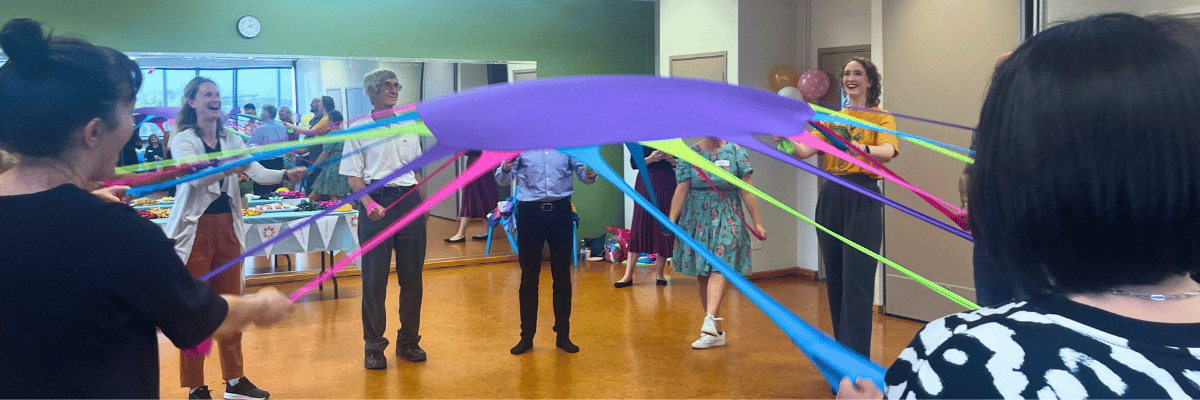Around the world, dance movement therapy is increasingly being used as a tool to heal the body and mind. It is founded on the assumption that the body and mind are interrelated, and that changing movement patterns affects change in other areas. Christine de Brenni, who submitted her thesis for her Masters in Dance Movement Therapy (DMT) at the University of Auckland, explored the healing aspect and processes of dance itself and within dance movement therapy. Here’s what she learnt.
Dance with Rhythm
Christine explains that rhythm is shared by all people and is universal. Even the foetus first sensual experiences are derived from the rhythms of internal function. It is undeniable that rhythm is inherent in human nature – our emotions, breath, internal functions, circulatory state, brain waves, and muscle action. All operate on a rhythm and can be seen as the most profound catalyst in dance movement therapy.
Christine states that rhythm is crucial in giving order to our lives and reconnecting us, especially in times of stress and trauma. It connects one to self, to others, and the environment; and when an individual is troubled, these rhythms can often get disrupted.
So how can dancing with rhythm be beneficial and healing?
Dancing with rhythm helps to organise the expression of thought and feelings into meaningful dance action (Levy, 2005). Studies have shown that children that have experienced abuse or trauma often experience tension through their bodies and facial expressions. Through moving rhythmically, people can release tension both physically and psychologically, and thus derive therapeutic benefit (Boswell, 2005).
Dance with Music
Music sets up a certain vibration which results in a physical reaction. Christine explains that there is an interconnection between music and rhythm as “we tap into rhythm with the music”. She says that in a dance movement therapy session, musical rhythm is used as the initial stimulus to awaken innate neuromuscular responses to music.
Numerous studies have shown that music can have a positive effect on healing. Christine highlighted the fantastic effect of enhancing muscle coordination as people move and dance in time with music – however music is mostly a prop in dance movement therapy (Frizell, 2008, as cited in de Brenni, 2021). Christine says that music is a neglected but intrinsic aspect of dance movement therapy that requires further research, particularly its role in facilitating healing or underpinning benefits.
Dance with Connection to Nature and the Physical World
By dancing with nature we can be constrained and moved by external rhythms, which can compress and expand or enhance our lives. This connection with the exterior rhythms of the natural world is often lost because dance movement therapy is conducted mostly inside a studio (de Brenni, 2021). She states that the wonders of moving in a natural world and the potential use of outdoor water environments or ‘blue space’ in the promotion of human health and wellbeing should be explored further.
So how can dancing in connection with nature be beneficial?
Countless studies show that being in nature or even viewing natural scenery can have a profound impact on your emotions – such as reducing anger, fear, and stress. Exposure to nature not only has an emotional impact, it also contributes to wellbeing. For example, it can reduce blood pressure, heart rate, and muscle tension (University of Minnesota, 2016). John, an interviewee of Christine’s study, explained how surfing is like dancing on water. He experiences extreme feelings of wellbeing and satisfaction by being in contact with nature.
The idea that health and wellbeing are related to the land, has long been integrated in the Māori worldview (Te Ao Māori). Traditional Māori health acknowledges the human connection with whānau and the physical world. This worldview identifies an integrated life concept that recognizes the interconnectedness of all aspects of being, environmental, ancestral, familial, and spiritual (de Brenni, 2021).
Dance with a Partner
Lastly, Christine explored the concept of partner dancing as a key healing element in dance movement therapy. John (an interviewee) explained that partner dancing is an important aspect of dance – like tango – where the leader listens to music, steers and takes control of the movement, while the follower must adapt, cooperate and trust their partner in the process. It’s difficult to do because you have to consider the other person’s movement and move together.
Christine shared many programmes had been developed and facilitated for couples where one person is living with dementia and the other is the carer as partner dancing may help renew and maintain the relationship between such couples. A study at The University of Illinois involved a Latin ballroom dance programme for older adults leading sedentary lifestyles. Results showed improvements in memory, attention, and focus. Another programme, studying elderly people with mild cognitive impairment, showed that after 10 months of dancing participants experienced an improvement in thinking and memory (Swayden, 2020).
DTNZ programmes
We offer a variety of dance movement therapy programmes to support people in a variety of situations. Our Dance 4 Us and STARS programmes promote group cohesion, cooperation and coordination for people living with a disability. A carer or a client’s nominated support person often partners with their client (or family member) in certain exercises, moving together to develop their bond and trust in each other. Our therapists explore different themes, and looks at ways to improve a client’s wellbeing, self-esteem, social and communication skills. Through our individual and ACC ISSC trauma therapy we help people working through a range of physical and emotional traumas. Call us or take a look at our programmes for further information.

